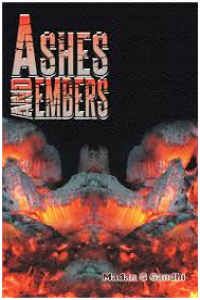Creation and Criticism
ISSN: 2455-9687
(A Quarterly International Peer-reviewed Refereed e-Journal
Devoted to English Language and Literature)
Vol. 02, Issue 04 : Jan 2017

Ashes and Embers by Madan G Gandhi
Gandhi, Madan G. Ashes and Embers. New Delhi: Vikas Bharti, 1982. Price: Rs. 100/-. Pp. 50. ISBN: Not Acquired.
Reviewed by Sudhir K Arora
Madan G. Gandhi strongly believes that “a poem is not a poster, nor a mere social criticism.” “Poetry” for him is “a creative recreation of life in the moments of stark encounters with it.” Ashes and Embers, a collection of 40 poems offers the poet’s ideal and attitude.
The title ‘Ashes and Embers’ which is derived from one of the poems of the poetry collection is very suggestive, appropriate and picturesque as it creates an image of ashes that have embers. Ashes exhibit the unfulfilled dreams. The embers or sparks are needed to light the fire to make the dreams true. The poems in this collection exhibit the embers of rebellion in ashes—sometimes in subdued tones and sometimes in forceful tone against injustice. The burning sands, the broken visions, and fleeting fancies possess something fruitful though outwardly speak of the naked reality of failure, despair and frustration. How beautifully he mentions the things that determine themes!
Light and shade
Smiles and tears
Birth and death
Hopes and fears
Are the ores, the flux of songs
Lava flows through the verses
And gives them shape
It is sad that the destroyer has become saver and the saver destroyer. No Krishna comes to help Draupdi who is robbed by her own relatives with a feeling of pride and honour.
Draupdi is disrobed
With mystic rituals
And blowing of conchs
The poet reveals the revolutionary spirit when he declares: “I carry both fire and steel / To burn and raze / The weeds and woods.” He knows that Brahma is the only ultimate reality. Hence, he asks for salvation for all. He dreams of an ideal world where all will be free and where exploitation will not be allowed.
Madan G. Gandhi uses the colours of patriotism, injustice, revolution, love, realism, freedom, salvation, death etc. to paint the canvas of Ashes and Embers. He has shown his revolutionary spirit in the poems like ‘Revolution’, ‘Second Coming’, ‘The Long March’, Last Symphony’, and ‘Epitaph.’ Poems like ‘Salvation’, ‘Ripeness is All’, ‘Twilight’, ‘Resurrection’, and ‘Second Homecoming’ are religious, mystical and symbolical. He uses scientific terms like ‘radiates’, ‘dissect’, ‘chemistry’, ‘compounds’, ‘mixtures’, ‘molecule’, and ‘particle.’ Terms like lave, thunderbolt, tempest, map, chart, waves, granite reveal his geographical knowledge. His phraseology is appealing and suggestive while his smiles and metaphors are telling and impressive.
Overall, Ashes and Embers makes a nice and useful reading. The poet moves with a flame and inspires others. He succeeds in his mission of imparting the message. This poetry collection has the spark to ignite the readers who feel with the poet. Here lies the success that counts.
 The Reviewer:
The Reviewer:
Sudhir K. Arora (b.1968) teaches English at Maharaja Harishchandra P. G. College, Moradabad affiliated to M. J. P. Rohilkhand University, Bareilly. He has several significant publications to his credit including Aravind Adiga’s The White Tiger: A Freakish Booker and Cultural and Philosophical Reflections in Indian Poetry in English in Five Volumes.


